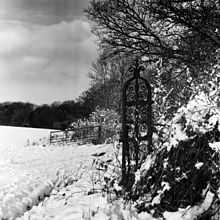Pyrgo Park
Pyrgo Park is a park at Havering-atte-Bower in the London Borough of Havering, in northeast London, England. It is the site of Pirgo Palace, built before 1540 and demolished by 1814; and of Pyrgo House, built 1841, which lasted less than a century. It is one of three large parklands in Havering-atte-Bower, the others are Bedfords Park and Havering Country Park.

Toponymy
Purgore is first recorded in 1490 and probably means 'triangular plot of land where pear trees grow'. It is formed from Old English 'pyrige' and 'gāra'. Pergore park is first recorded in 1544 and had become Pergo Park by 1805.[1]
Palace
Pirgo, spelt Portegore by Henry VIII’s officials, was a royal residence of King Henry VIII, from 1541, situated by the park of the royal palace of Havering in the Liberty of Havering-atte-Bower. Providing a pleasing position on a gentle ridge barely twenty easy miles from London with wide views west, Havering had more than six centuries of association with royalty. King Edward the Confessor (1003-1066) is said to have been disturbed there at his devotions by nightingales and prayed successfully for their banishment from Havering Park. Havering Palace continued to be used by successive monarchs until 1638 and Havering Park remained with the Crown until 1828. A new house was built on the site in 1841 and has since been demolished.
King Henry VIII and Pirgo
About 1536 the king's steward made a smaller park at Pirgo, north-east of Havering village and the King made it his personal property. The steward continued to live at Pirgo until about 1541.
Henry VIII had the house repaired and completed the emparking of Pirgo.
The succession to the crown
The King is said to have summoned his estranged daughters, Mary and Elizabeth, to his new house at Pirgo in 1542 and being pleased with them he made the decision to reinstate them in the succession to the Crown.
Royal Gift to Lord John Grey
On 24 April 1559, a few months after her accession to the throne, hearing his plea of poverty, Elizabeth gave the manor with its royal residence to her second-cousin, Lord John Grey, uncle of Lady Jane Grey, from that time on known as Lord John Grey of Pirgo.
Description
The first available description dates from 1594 when the former royal residence was described as 'a fair house', shown on a map dated about 25 years later as a large gabled building. In 1670 taxes were paid on 30 hearths. The site, terracing of the gardens was still visible after WWI, was northwest of the surviving farm buildings and was partly excavated in 1972. An old iron Tudor period gatepost remains in Pyrgo Park.
Pirgo had a small chapel in which were Grey family tombs, and floor slabs to several members of the Cheeke family. All the Cheeke remains were removed to the parochial chapel of Havering about 1768.
- . . . a tomb in the chapel of the mansion house at Pirgo in Essex; on which was a knight kneeling with four sons, his lady kneeling with four daughters, and many coats and quarterings; and bearing on the verge this inscription:
- "Here under lyeth buried the lorde John . . . Grey, Knyght (fourth son of) the lorde Thomas Grey mar . . . . . ques Dorcet, who dyed the xix daye of November 1564; and dame Mary his wyfe, daughter of Sir Anthony Browne, Knyght of the Garter, mr of the horse, and con'seler to Kynge Henry ye VIII. Dame Mary dyed . . . .
- from Arthur Collins; Peerage of England, published 1812
Demolition
Between about 1771 and 1778 the Archer family demolished the chapel and the wings of Pirgo House. It continued in use for a short time, but the remainder of the former royal residence seems to have been demolished by about 1814.
Owners and Residents after Henry VIII
- In 1559 Elizabeth I granted Pirgo to Lord John Grey, only surviving son of the 2nd Marquess of Dorset and uncle of Lady Jane Grey. Lord John Grey was the sole surviving brother of:
Henry Grey, duke of Suffolk executed in 1554, Lord Edward Grey and Lord Thomas Grey executed in 1555.
Lord John Grey, himself once condemned to death, had been disallowed as sole surviving male heir of his father. - Lord John's son Henry later Lord Grey of Groby.
- Henry's grandson Henry Grey, later earl of Stamford, who in 1621 sold Pirgo to:
- Sir Thomas Cheek who died in 1659. The manor passed through various descendants but ultimately to his granddaughter Ann, daughter of Thomas Cheeke, and wife of ;
- Sir Thomas Tipping. His younger daughter, Katherine, married;
- Thomas Archer. In 1790 the trustees of their four granddaughters sold Pirgo to Edward R. Howe.
New house
In 1852 a new house was built on the site. The house and 600 acres (2.4 km2) of neighbouring farms were sold to Albert Fytche in 1873.[2] The house came within the metropolitan green belt and was demolished by 1941.
References
- Images
- Notes
- ↑ Mills, D. (2000). Oxford Dictionary of London Place Names. Oxford.
- ↑ "Pyrgo Park".
- Bibliography
- W.R.Powell (editor) (1978). "Parishes: Havering-atte-Bower".
| ||||||||||||||||||||||||||||||||
